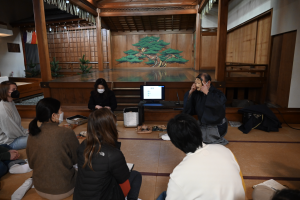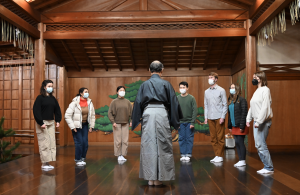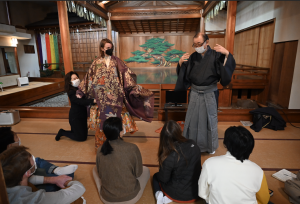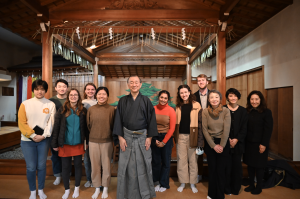Introduction:

Haruhisa KAWAMURA (河村晴久, b. 1956) is a noh performer for the Kanze School, mainly active at the Kyoto Kawamura Noh stage. He made his stage debut at the age of three while being taught by his father, the noh performer Haruo Kawamura. He is a visiting professor at Doshisha University, where he attended graduate school. In 2005, he was in the United States and Canada as a cultural exchange envoy of the Agency for Cultural Affairs, and he received the Kyoto Prefectural Cultural Award Distinguished Service Award in 2020. He is a member of the Japan Nohgakukai.
Kawamura-sensei’s thoughts on noh and instruction:
“Noh becomes more and more attractive when you actually experience it as well as appreciate it. We are practicing Noh’s chanting, which is a song, and the movement, which is a dance. We will not only convey the techniques, but also the contents and background of the works, so that you can experience the profound world of Noh, with fun stories. We are also devising short-term courses and online lessons that can be taken from anywhere. English is also available.”
“Learning begins with imitation.”
“However, what I personally think is the heart, the feeling, the thoughts, I think that without such things, it will not lead to a true impression.”
“Let me give you an example of a class I took this year. The first thing I would say is don’t believe anything I say. Criticize me. I’ll try to be as fair as possible, but since I’m speaking through my filter, it’s okay to use your own judgment and flip what I’m saying.”
“Noh is something that Noh actors have desperately changed in order to survive.”
“Noh portrays divine blessings, requiems, and humans in extreme conditions. What are humans, and what have humans been doing since ancient times?”
“I want people to become interested in what kind of predecessors there were and what they did in their own towns and villages. And I want you to see the wide world on that. I want you to look at your feet to spread out.”
“I want you to have what you are talking about inside you. I want more people to be able to speak with confidence about the Japanese values of accepting anything and accepting diversity. I wish I could make that kind of change.”
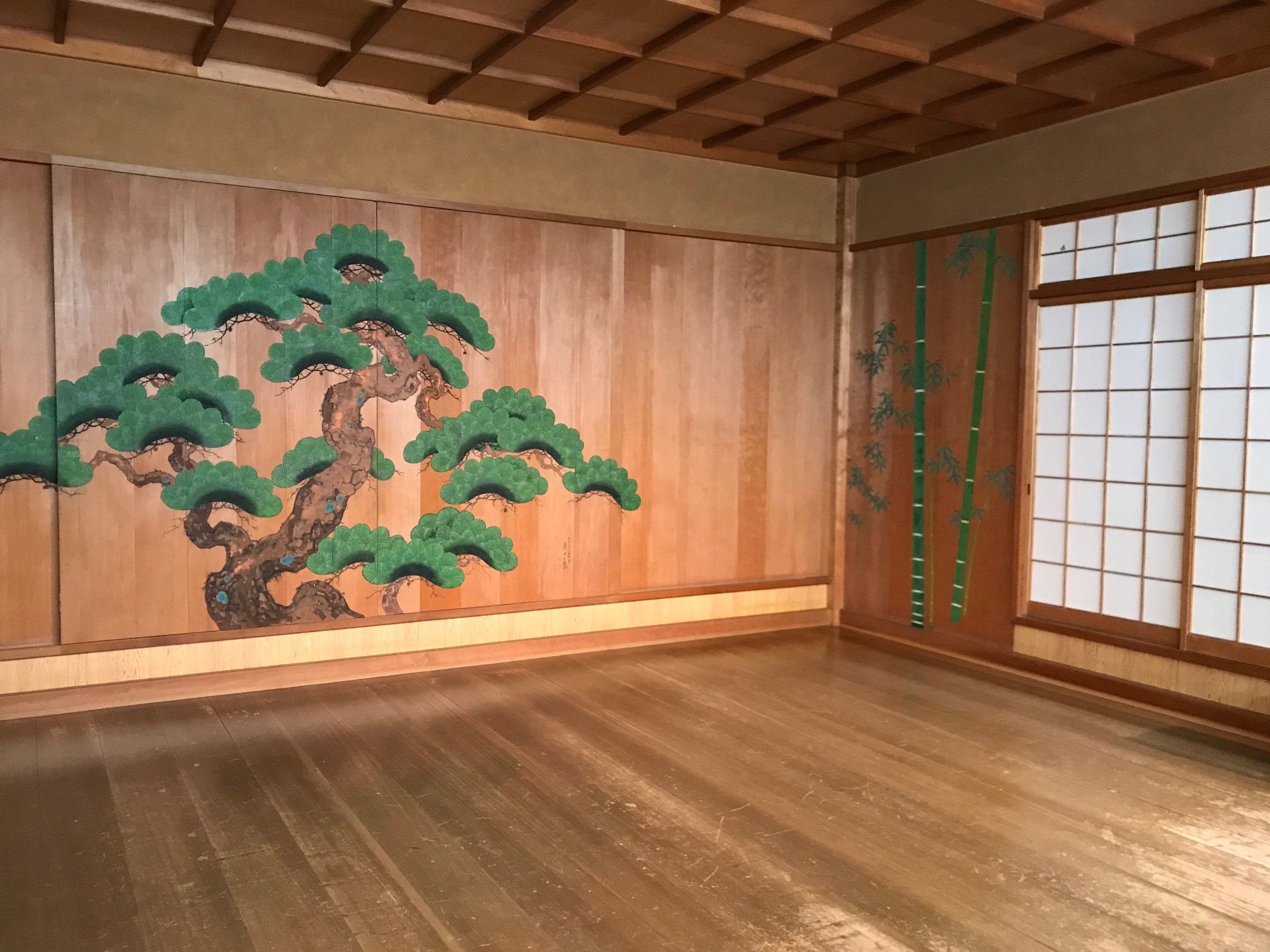
Questions Brainstorm:
- How do you connect the earthly world with the spirit world?
- How do you create your stage presence?
- What is your process to get into character?
- What is the relationship between your inner conscience and your outer physicality?
- What is your relationship with your mask and costume?
- How does noh interact with Zen, Amidism, Shinto, and other religions and traditions?
- Do different settings impact your approach to performing? In which dream setting would you like to perform?
- Are you concerned about noh‘s role and popularity in the present?
- How will you pass on your practice to the next generation?
- What are noh‘s next steps in the future?
- What are the capabilities of noh though and on social media?
- Are you a football fan (thoughts on the World Cup?), and do you think there is a relationship between football and noh?
- How do you modulate your professional self versus your personal self?
~~~~~~~~~~~~~~~~~~~~~~~~~~~~~~~
Reflection from 1/15 and 1/16:
The overwhelming feelings of our group upon walking out of the theater after a four hour long Noh performance might be best described as disbelief. How do they maintain those chants for so long? Why was it so comfortable in the space despite the seemingly intrusive drums and flute playing? Did four hours really go by?
…Was that performance real?
For those uninitiated to the tradition of Noh theater, I would venture to guess those are common reactions to viewing it for the first time. For those familiar with the art, I might even say the same. The act of watching Noh is such an incredibly ethereal, dreamy, transportive experience, it almost feels like each time you sit down in one of those identically built theaters, it’s as if you’re entering the space for the first time. Immediately after the performance, there weren’t really words to describe how I was feeling. There was a strange mix of awe, confusion, curiosity, and even disappointment; I didn’t initially connect with the plays as deeply as I thought I would have. As an actor myself, that discomfort sat with me, since I had studied the art form previously and really wanted to understand it. But for the untrained like myself, pure appreciation felt unattainable.
Turns out, I just needed to go to the master.
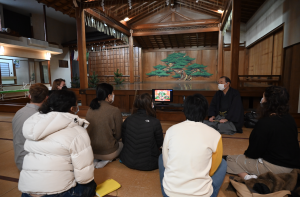
Kawamura Haruhisa’s family has been in the Noh tradition for many generations. As such, he contains a wealth of knowledge about Noh’s history, performance techniques, themes, and so on. And as a visiting professor as Kyoto’s prestigious Doshisha University, he’s also a very talented and charismatic educator. He took our group, college students from Massachusetts with little to no knowledge of his art form, and patiently explained his perspective on Noh, complete with physical demonstrations and hands-on learning. It was a complete, fulfilling, informative, and genuinely fun experience that I left with a somewhat drastically changed view of the craft.
For those who, like us, are unfamiliar, Noh is a traditional type of Japanese theater that is characterized by its length, unique way of delivering lines, and punctuating instrumental accompaniment. Lines of dialogue are slow, chanted or sung in deep, warbling tones, stretching out words so extremely that many people who have been speaking Japanese since childhood have difficulty understanding it. Because of this, programs of the day’s performance include short description of the plays’ contents. The same Noh plays have been performed for hundreds of years, so audiences that frequent shows will likely have seen some of the same stories being told multiple times, albeit in different ways. Because of this, I came to understand that the enjoyment of Noh isn’t necessarily about understanding every line of dialogue, or every action, or every second of the play’s contents, but instead about the environment that the specific troupe was cultivating on that particular afternoon.
When Kawamura-sensei spoke to us about Noh, we could just feel his connection to the art form. Periodically throughout his presentation, he would stand, walk to the stage, and demonstrate the particular song or action he was describing to us. When we saw the performance, the movements of the performers were somewhat of a mystery to us, and, beyond the description of the plays in the program, the storytelling was also slightly confusing. Now, though, after Kawamura-sensei’s presentation, we can recognize the movement of the arm as an expression of love, or hate, or an appreciation of the moon. I went from being a little frustrated with my inability to understand or connect with Noh, to wanting to go back out and watch more of it.
Our theme of this course is inochi, and, knowing this, Kawamura-sensei’s talk was also centered on Noh’s connection to the different areas of life and performance that inochi can be seen and felt. Two parts in particular stuck out to me: the performer’s connection to the masks themselves, and the lasting properties of Noh plays. We saw a little bit of the power that the masks hold when we visited Udaka-sensei, but from the perspective of a carver. Naturally, a performer has a different relationship as a collaborator and vessel for the spirit of the mask. I was especially touched when Kawamura-sensei showed us the Okina mask from his family’s collection; You could feel the history contained within its spirit, as well as the deep bond that he had formed with it. While it was present, it was easy to see how the ritual and performance of Noh brings about inochi in the environment and within the actors and masks themselves.
The other section that stuck with me was when Kawamura-sensei described Noh as a contemporary art. One of the defining features of Noh is its long history within Japan, so having it be described as an art form within and for the present day was slightly surprising. However, as he explained it, it suddenly made a lot of sense. An art form can have existed for a long period of time, but if new works are still being created or circulated in the present day, the artists who are circulating those works are doing so for a contemporary audience, thus bringing the art form itself into a contemporary space. Through this understanding, Noh can also be viewed as a traditional art form, or a contemporary one, or even a future one. This inter-temporality of the performance art is what continues to circulate inochi through the audiences, performers, carvers, textile weavers, and every person that comes into contact with Noh. It is a timeless art, it is a spiritual art, and it’s maybe a confusing art, but most of all, it is an art that will continue on and spread its message of peace and understanding of nature for audiences here and now, audiences far away, or audiences to come.

